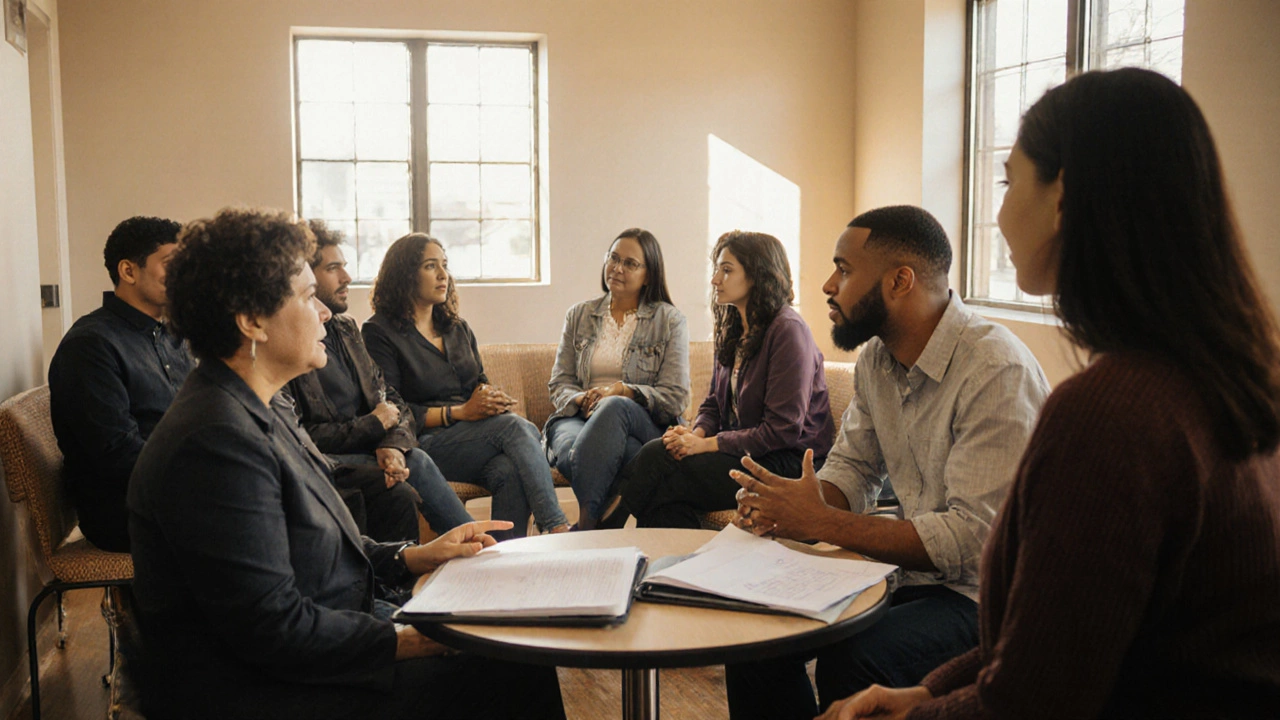Rapid Re-Housing Eligibility Checker
Check Your Eligibility
This tool will help you determine if you qualify for Rapid Re-Housing assistance based on current criteria from HUD programs. This is not an application process - it's just a quick check to see if you might be eligible.
Eligibility Results
Enter your information above and click "Check Eligibility" to see if you qualify for Rapid Re-Housing assistance.
Why You Qualify
Next Steps
Remember
This is a tool to help you understand eligibility. For the actual application process, contact your local housing authority or call 211.
If you’re sleeping in your car, staying with friends, or living in a shelter, you’re not alone-and help is closer than you think. Rapid Re-Housing isn’t a luxury program. It’s a federal-backed lifeline designed to get people out of homelessness and into stable housing fast. But knowing how to qualify isn’t always obvious. You don’t need perfect credit, a job lined up, or a long application process. What you need is to understand the rules, know where to go, and act quickly.
What Is Rapid Re-Housing?
Rapid Re-Housing is a program funded by the U.S. Department of Housing and Urban Development (HUD) and run locally by cities, counties, and nonprofits. It gives people experiencing homelessness temporary financial help and case management to move into their own apartment or house. Unlike long-term public housing, this isn’t about waiting years for a unit. It’s about getting you housed in days or weeks.
The program covers rent for a few months-usually 3 to 6, sometimes up to 12-plus help with security deposits, utility bills, and moving costs. You also get a case manager who helps you find housing, apply for benefits, and stay housed after the financial help ends.
It’s not a handout. It’s a bridge. And it works. Studies show 80% of people who enter Rapid Re-Housing stay housed after one year.
Who Qualifies?
You don’t need to be homeless for months to qualify. In fact, you qualify if you’re:
- Living in a shelter, transitional housing, or a place not meant for human habitation (like a car, abandoned building, or park)
- Staying with friends or family because you have nowhere else to go (known as doubled-up)
- At risk of homelessness within 14 days-like if you’ve been evicted or your landlord is kicking you out
There’s no income cap, but your income must be low enough that you can’t afford housing on your own. Most programs use 30% to 50% of the Area Median Income (AMI) as a guideline. For example, in a city like Atlanta, that means earning under $30,000 a year for a single person. In higher-cost areas like San Francisco, it might be $50,000 or more.
Immigration status doesn’t disqualify you. Undocumented individuals can qualify if they meet the homelessness criteria. Veterans, survivors of domestic violence, youth aging out of foster care, and people with disabilities are prioritized-but everyone is eligible.
How to Find Rapid Re-Housing Near You
There’s no national website that lists every program. You have to go local. Start here:
- Call 211-it’s a free, nationwide helpline that connects people to local services. Say you’re looking for Rapid Re-Housing. They’ll give you the name, phone number, and address of the nearest provider.
- Visit your local homeless coalition. Every major city has one. Search "[Your City] homeless coalition" or "[Your County] housing authority". These groups coordinate all housing programs in your area.
- Go to a shelter or food bank. Staff there know exactly which programs are accepting applications right now. Many shelters have on-site case managers who can start your application the same day.
- Check with HUD-approved housing counseling agencies. These are nonprofit organizations certified by HUD. You can find them at hud.gov/hcc.
Don’t wait for a referral. Walk in. Call. Show up. Programs are often understaffed and overwhelmed. The faster you reach out, the faster you get help.

What Happens When You Apply?
There’s no long form. No credit check. No background check for criminal history (unless you’re a registered sex offender). The process is simple:
- You’ll be asked to prove you’re homeless or at risk. A letter from a shelter, eviction notice, or even a signed statement from a social worker works.
- You’ll meet with a case manager for a short interview-usually 20 to 30 minutes. They’ll ask about your income, family size, and housing goals.
- If you qualify, they’ll start looking for housing with you. Many programs have partnerships with landlords who accept vouchers.
- You’ll sign a lease in your name. You’re not renting from the program-you’re renting from a private landlord.
- Financial help kicks in within 7 to 14 days. Rent goes directly to the landlord. You pay a small portion-usually 30% of your income-toward rent.
Case management continues for as long as you need it. That might mean helping you get a job, apply for food stamps, or find childcare. The goal isn’t just to get you a roof-it’s to make sure you keep it.
What If You’re Turned Down?
Most people aren’t denied. But if you are, it’s usually because:
- You’re not actually homeless or at risk-like if you’re living in a paid apartment, even if it’s overcrowded
- There’s no funding available right now-programs run on grants and sometimes have waiting lists
- You’re already receiving other housing assistance, like Section 8
If you’re turned down, ask why. Then ask: “What other programs do you recommend?” Most agencies have backup options-emergency rental assistance, transitional housing, or short-term vouchers.
Don’t give up. Apply to more than one program. Call 211 again. Visit a different shelter. Keep trying. Resources shift every week.
What You Can Do Right Now
You don’t need to wait for a perfect moment. Here’s what to do today:
- Write down your current address and how you’re living (car, couch, shelter, etc.)
- Call 211 or go to your nearest homeless service center
- Bring any documents you have: ID, birth certificate, Social Security card, eviction notice, or pay stubs
- Ask: “Do you have openings in Rapid Re-Housing?” If they say no, ask: “What’s the next step?”
If you’re in a rural area, don’t assume there’s no help. Many rural counties partner with regional nonprofits or state agencies to offer Rapid Re-Housing. Call your county social services office. They’ll know.

Real Stories, Real Results
Marisol, 42, was evicted from her apartment in Phoenix after her hours were cut at the diner. She stayed with her sister until her sister’s landlord threatened to evict her too. She called 211 on a Tuesday. By Friday, she had a voucher. On Monday, she signed a lease for a two-bedroom apartment. Her rent was $650. She paid $195. The program covered the rest for six months. She got a new job in July. She’s still in that apartment today.
James, 19, aged out of foster care with no place to go. He slept in a library until a case worker from the local youth housing program found him. He got a Rapid Re-Housing voucher, help finding a studio apartment, and weekly check-ins. He’s now in community college, working part-time, and paying his own rent.
These aren’t rare cases. They’re the norm.
Common Myths About Rapid Re-Housing
- Myth: You need to be sober to qualify. Truth: No. Substance use doesn’t disqualify you. Many programs offer support for recovery, but they won’t turn you away.
- Myth: You have to be a veteran or have a disability. Truth: Anyone can qualify. Veterans get priority, but they don’t get all the slots.
- Myth: It takes months to get approved. Truth: Most people are housed within two weeks.
- Myth: You’ll lose your benefits if you get housing. Truth: Getting housing doesn’t affect SNAP, Medicaid, or SSI. In fact, stable housing often makes it easier to keep them.
Can I get Rapid Re-Housing if I have a criminal record?
Yes. Most Rapid Re-Housing programs do not run background checks for criminal history. The only exceptions are registered sex offenders. If you’ve been denied before, ask for the reason. Many programs will work with you if you’re willing to participate in case management.
Do I need to be unemployed to qualify?
No. You can have a job and still qualify if your income is too low to afford housing. Many people in the program work part-time, seasonal jobs, or receive disability payments. What matters is whether you can pay rent without help.
Can I use Rapid Re-Housing to move to a different city?
Generally, no. The program is tied to your local area. You must be homeless or at risk in the county where you’re applying. If you want to move to another city, you’ll need to apply for housing assistance in that new location. Some programs offer relocation assistance, but it’s rare.
What if I have pets?
Many landlords who work with Rapid Re-Housing allow pets, especially service animals or emotional support animals. Some programs help cover pet deposits or fees. Tell your case manager you have a pet-they’ll know which landlords accept them.
How long does the financial help last?
Usually 3 to 6 months, but it can go up to 12 months depending on your needs and local funding. The goal is to help you get back on your feet. After that, you pay full rent, but your case manager will help you plan for it-like applying for housing vouchers or increasing your income.
Next Steps: Don’t Wait
If you’re reading this and you’re without stable housing, the next thing you do matters more than anything else. Don’t wait for a crisis. Don’t wait for someone else to help you. Call 211. Walk into a shelter. Ask for Rapid Re-Housing. Programs are there because people like you asked for them.
There’s no shame in needing help. There’s only shame in giving up. You’re not broken. You’re in a hard season. And help is real. It’s waiting for you to reach out.
